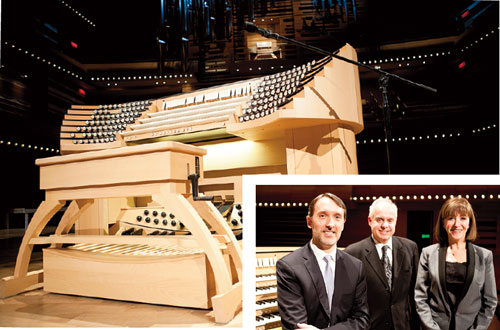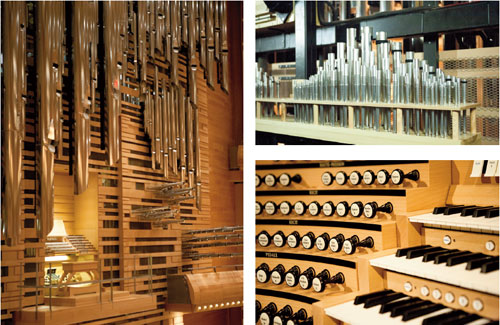The Grand Pierre-Béique Organ: A Historic Premier at the Maison Symphonique by Christine Man-Ling Lee
/ April 1, 2014
Version française...
English version PDF

Olivier Latry, the OSM's organist emeritus; Jacquelin Rochette, artistic director of Casavant
Frères; and Madeleine Carreau, CEO of the OSM. Photos: Alain Lefort
The Grand Orgue Pierre-Béique represents nearly five years (and for some, eight years) of combined efforts by the OSM; Olivier Latry, OSM’s organist emeritus; architects Diamond Schmitt + AEdifica, and Casavant Frères. From this moment forward, the Orchestre Symphonique de Montréal has a new family member at the Maison symphonique: the Opus 3,900. The instrument, built by the world-renowned Casavant Frères, has four keyboards, 109 registers, 83 stops, 116 ranks and 6,489 pipes. Its name pays tribute to the OSM’s founder and first general manager, and acknowledges his remarkable contribution to the orchestra’s mission of excellence.
The orchestra’s loyal followers will have witnessed the gradual evolution of the organ’s façade, which included the addition of three series of pipes, horizontal and perpendicular to the ground. The latter are reed pipes, in which air pressure causes the languet to vibrate to produce sound, much like the vibration necessary to play a clarinet or saxophone.
The façade, however, is just one part of the massive creature that is the Grand Orgue. Behind the hundreds of pipes, which are illuminated by blue light, is a four-level construction made up of all the other reed and flue pipes, as well a large part of the technology allowing for a second console on the stage.
“The bellows are housed in the basement, where three ventilators provide air for the instrument. The console and the pipes for the second keyboard, the Positif, are found on the first level. One level up, the Grand-Orgue and the Grand-Chœur are found, which are the first and fourth keyboards, respectively. On the last level is the récit, which is the third keyboard,” explains Denis Blain, Casavant Frères’ technical director.
The smallest pipes are 10-12mm maximum, and the largest are up to 32 feet high; their impressive height can be admired on the façade. The pipes are all made of the same metal alloy, with differing compositions of tin and lead (with the exception of the wood pipes). “The pipes with the most powerful sound are made with a higher concentration of tin, whereas the pipes with a softer sound, like that of the flute, are made with a higher concentration of lead. The principals are between the two, made up of equal parts tin and lead,” explains Blain. The groundwork for the majestic instrument was formidable and the result of the combined effort of approximately 60 workers over the course of two years. “Not only were the pipes all handmade,” Blaine says, “but the metal was also cast in the workshop.”
An Acoustic Puzzle
The Maison symphonique is one of Montreal’s top acoustic spaces for orchestra. The room’s acoustic reflectors are paramount in attaining a strong acoustic balance. The panels, however, caused headaches for the crew with the addition of the new family member. “Depending on the point from which we hear the organ, the sound changes. For example, where the reflectors are lower than the pipe openings, the sound is different from one spot in the room to the next,” says Blaine. “The best sound for the organ is therefore when the reflectors are on the ceiling.” A trial, break-in and adaptation period is therefore essential for the positioning of the reflectors, the organ and the orchestra musicians as well as for conductor Kent Nagano.
A New Era
The Grand Orgue Pierre-Béique is among the world’s most noteworthy orchestral organs. Not only was it designed to complement the nuances and dynamics of an orchestra, but it can also blend with its sound and timbre. In fact, the sound of the organ was developed so that it can, as Olivier Latry explains, “model itself after and be like the orchestra,” particularly through its momentum, which characterizes the thralls and sounds of the orchestra. Furthermore, having a second console at orchestra level helps integrate the organ with the orchestra thanks to the cohesive sound the organist hears when among the other musicians. The second console was installed at orchestra level thanks to technology; electronic transmission via a network cable controls a second type of action inside the organ. The only drawback is that “we feel nothing beneath our fingers,” explains Latry. He goes on to explain that, despite this drawback, he prefers the second console; a “cohesive sound” is more important: “We hear basically what the audience hears.” Furthermore, Latry finds the contact with the other musicians extremely valuable: “We are truly there, amid the orchestra, next the conductor, with the musicians. There is sight, breath; it’s all there.” The console can even be moved anywhere on the stage.
As for the first console, it is attached to the organ (and has to be, from a mechanical point of view) and is situated a few metres above the orchestra. There, the organist has better contact with the sound, and manages to “feel everything that passes beneath his fingers,” which makes for a more pleasant experience for the musician.
The arrival of the Grand Orgue marks an obstacle overcome, a new level, not only for the OSM, Casavant Frères and all other collaborators, but also for Montreal’s cultural landscape. “This will be the first orchestral organ installed in a symphony hall,” explains Jean-Willy Kunz, the resident organist at the OSM. “For the first time in Montreal, we will be able to hear repertories—many repertoires—for organ and orchestra.” This isn’t for lack of effort: “Conditions never allowed for it,” explains the organist. “Organs were in churches, where layouts don’t always allow for a large orchestra. Also, acoustics in churches aren’t favourable to orchestral music.”
“Here at the Maison symphonique, all the conditions come together. The orchestra sounds magnificent in the space, as does the organ,” adds Kunz. It is therefore an ideal context in which “to bring new and unheard repertories to the public.”
Testing And The OSM
Jean-Willy Kunz was nominated as organist in residence following public auditions held on March 17, 2013. In view of the inauguration and all the work necessary to complete the varied projects related to the Orgue Pierre-Béique, the OSM launched a call for applications almost two years before the May 28, 2014, inaugural concert. The search for an organist culminated in final, open to the public, auditions held on March 17, 2013. The selection committee was made up of Maestro Kent Nagano, Olivier Latry, Pierre Grandmaison, John Grew, Jacquelin Rochette, Noël Spinelli and Patrick Wedd.

Construction and Harmonization
During the construction and harmonization period, Olivier Latry, tenured organist of the Great Organ of Notre-Dame de Paris, brought undeniable expertise and a wealth of knowledge about organs that allowed for the creation of the Grand Orgue Pierre-Béique, “a true musical instrument.”
“I’ve been very impressed,” notes Latry, “by the capacity of Casavant’s organ builders to develop and modify the organ’s sound settings on the basis of aimed-at results,” that is to say, an orchestral organ capable of offering a ‘wide range of tones,’ as well as a vast ‘orchestral palate’ working with timbres and musicality. Latry, incidentally, stayed up all night at the Maison symphonique on a few occasions in preparation for the official acceptance of the organ, the last step in the process.
Official Acceptance
January 16, 2014, marked a momentous occasion for the OSM and all participants in the project: the official acceptance of the Grand Orgue Pierre-Béique, a contractual procedure confirming receipt of the instrument, where a rigorous inspection takes place once the installation is complete and the organ is ready for use.
“With this acceptance, harmonization work on the OSM’s Grand Orgue Pierre-Béique is now concluded,” declared Olivier Latry. “The organ will sound different under the fingers of each organist.” He continued to explain that the unique characteristics of the organ, specifically “its adaptability, the great variety of its timbres and their wonderful musicality will be important assets in the performance of works with orchestra and organ repertoire.”
Jacquelin Rochette received the acceptance on behalf of Casavant Frères with “joy and humility.” “The Grand Orgue Pierre-Béique is quite certainly the most accomplished instrument that we’ve had the opportunity to build,” he said.
At the acceptance event, Latry played Marcel Duprés’ Cortège et Litanie on the organ, a piece intended for organ and orchestra. Although only the organ was played, tubular bells and glockenspiel were also heard at the beginning and end of the piece. Jean-Willy Kunz explained the mystery. “There is a set of bells inside the organ, tubular bells. The notes of two octaves, from G to G in the centre of the keyboard, are linked to the tubular bells through a mechanical device.” This is the sound heard at the beginning of the piece. The second bells heard were the glockenspiel. “These are small bells fixed onto metal circles that turn with the help of another mechanical device.”
The instrument’s majestic sound and its secrets will soon be revealed, but for the moment, a break-in period with the orchestra musicians, Jean-Willy Kunz and Kent Nagano, will be necessary prior to the Grand Orgue’s official inauguration.
The Grand Orgue Pierre-Béique’s Future
Events designed to highlight the organ are planned for the OSM’s 2014-2015 season, such as the ORGAN series, which includes the premier of Jacques Hétu’s Organ Concerto, a recital featuring Olivier Latry and a projection of The Phantom of the Opera accompanied by a musical improvisation on the Grand Orgue.
The official inauguration will take place on May 28, 2014. Olivier Latry will play works by Bach, Saariaho, Liszt, Samy Moussa and Saint-Saëns. The inauguration week’s program will include concerts on May 27 and June 1, as will as an open house on May 31.
An interesting fact about Saint-Saëns’ Symphony no. 3, which will be played at the inauguration, is that it was created in London in May 1886. This presentation will therefore be a 128th anniversary of sorts for the piece. Also, Kent Nagano is currently working with the original partitions. The Grand Orgue’s inauguration will without a doubt be an incredible musical experience, not to be missed!
www.osm.ca
Translation: Elisabeth Gillies
Version française... | |

